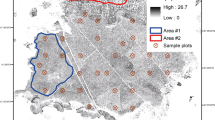Abstract
Based on temporal data collected from 36 re-measured plots, transition probabilities of trees from a diameter class to a higher class were analyzed for the broad-leaved-Korean pine forest in the Changbai Mountains. It was found that the transition probabilities were related not only to diameter size but also to the total basal area of trees with the diameter class. This paper demonstrates the development of a density-dependent matrix model, DM2, and a series of simulations with it for forest stands with different conditions under different harvest schemes. After validations with independent field data, this model proved a suitable tool for optimization analysis of harvest schemes on computers. The optimum harvest scheme(s) can be determined by referring to stand growth, total timbers harvested, and size diversity changes over time. Three user-friendly interfaces were built with a forest management decision support system FORESTAR® for easy operations of DM2 by forest managers. This paper also summarizes the advantages and disadvantages of DM2.
Similar content being viewed by others
References
Nakashizuka T, Iida S. Composition, dynamics and disturbance regime of temperate deciduous forests in Monsoon Asia. Vegetatio, 1995, 121(1–2): 23–30
Barnes B V, Xu Z, Zhao S. Forest ecosystems in an old-growth pine-mixed hardwood forest of the Changbai Shan Preserve in northeastern China. Can J For Res, 1993, 22(2): 144–160
Shao G, Zhao G, Zhao S, et al. Forest cover types derived from landsite TM imagery for Changbai Mountains Area of China. Can J For Res, 1996, 26(2): 206–216
Wu G, Xiao H, Zhao J Z, et al. Forest ecosystem services of Changbai Mountains in China. Sci China Ser C-Life Sci, 2002, 45(1): 21–32
Shao G, Zhao G. Protecting versus harvesting of old-growth forests on the Changbai Mountain (China and North Korea): A remote sensing application. Nat Area J, 1998, 18(4): 334–341
Dai L, Shao G, Chen G, et al. Forest cutting and regeneration methodology on Changbai Mountains. J For Res, 2003, 14: 56–60
Yan J Z, Zhang Y L, Bai W Q, et al. Land cover changes based on plant successions: Deforestation, rehabilitation and degeneration of forest in the upper Dadu River watershed. Sci China Ser D-Earth Sci, 2005, 48(12): 2214–2230
Zhang P, Shao G, Zhao G, et al. China’s Forest Policy for the 21st Century. Science, 2000, 288(5474): 2135–2136.
Shao G, Schall P, Weishampel J F. Dynamic simulations of mixed broadleaved-Pinus koraiensis forests in the Changbaishan Biosphere Reserve of China. For Ecol Manage, 1994, 70(1–3): 169–181
Peng C H. Growth, yield models for uneven-aged stands: past, present and future, For Ecol Manage, 2000, 132(2–3): 259–279
Buongiorno J. Quantifying, the implications of transformation from even to uneven-aged forest stands. For Ecol Manage, 2001, 151(1–3): 121–132
Buongiorno J, Peyron J L, Houllier F, et al. Growth and management of mixed-species, ineven-aged forests in the French Jura—Implications for economic returns and tree diversity. Forest Sci, 1995, 41(3): 397–429
Buongiorno J, Gilless J K. Decision Methods for Forest Resource Management. New York: Academic Press, 2003
Shao G, Zhao S, Shugart H H. Forest Dynamics Modeling: Preliminary Explanations of Optimizing Management of Korean Pine Forests (in Chinese). Beijing: China Forestry Publishing House, 1995
Shao G, Wang H, Dai L M. et al. Integrating stand and landscape decisions for multi-purposes of forest harvesting. For Ecol Manage, 2005, 207(1–2): 233–243
Zhao D, Borders B, Wilson M. A density-dependent matrix model for bottomland hardwood stands in the Lower Mississippi Alluvial Valley. Ecol Model 184, 2005, (2–4): 381–395
Porte A, Bartelink H H. Modeling mixed forest growth: a review of models for forest management. Ecol Model, 2002, 150(1–2): 141–188
Lin C R, Buongiorno J, Vasievich M. A multi-species, density-dependent matrix growth model to predict tree diversity and income in northern hardwood stands. Ecol Model, 1996, 91(1–3): 193–211
Chase W, Bown F. General Statistics. New York: John Wiley & Sons, 1986. 580
Dai L M, Zheng B F, Shao G F, et al. The roles of a decision support system in applying forest ecosystem management in Northeast China. Sci China Ser E, 2006, 49(suppl. I): 9–18
Kolbe A E, Buongiorno J, Vasievich M. Geographic extension of an uneven-aged, multi-species matrix growth model for northern hardwood forests. Ecol Model, 1999, 121(2–3): 235–253
Author information
Authors and Affiliations
Corresponding author
Rights and permissions
About this article
Cite this article
Shao, G., Wang, F., Dai, L. et al. A density-dependent matrix model and its applications in optimizing harvest schemes. SCI CHINA SER E 49 (Suppl 1), 108–117 (2006). https://doi.org/10.1007/s11431-006-8112-2
Received:
Accepted:
Issue Date:
DOI: https://doi.org/10.1007/s11431-006-8112-2




